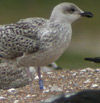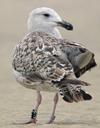 Great Black-backed Gull (Larus marinus)
Great Black-backed Gull (Larus marinus)
(last update: July 12, 2015)
Great Black-backed Gull 1cy July - August
Identification of juvenile plumage
Juvenile similar to Herring, Yellow-legged and Heuglin’s Gulls, but generally more contrasting ‘black and white’. Slower rate of development indicated from early age. [However, already by late August it may have started the moult in scapulars, as illustrated by this Danish individual].
Size and proportions are main points, but these are less obvious in females, which may be surprisingly small.
Compared to Herring it shows a heavier, black bill with a narrow pale tip. Acquires whitish forehead soon after fledging. Breast at most slightly dark-spotted. Mantle and scapulars darker brown with more distinct pale fringes than in Herring, appearing chequered and contrasting somewhat with paler-patterned wing-coverts. Especially greater coverts pale with narrow dark bars - mostly narrrower than pale bars and often creating pale panel against dark-centred secondaries, often evident in flight. Tertials blackish with irregular white edges and broad white tips. Primaries blackish, white tips to blacker outer primaries often broader than in Herring.
Juvenile Herring is a less contrasting greyish-brown with denser brown streaks on the head and breast, less distinct pale pattern to the upperparts and a dark-marked lower belly. Greater coverts generally with broader dark bars (mostly broader than or equal to pale bars, matching dark tertial centres). Most Herring acquire a pale bill-base from late autumn.
In flight, wing pattern similar to Herring, but inner primaries darker with weaker (if any) pale window, and the darker secondaries contrast better with the pale greater coverts. The dark tail-bar is typically weaker, appearing diluted with broader white bases and edge; the strong white edge to the tail-sides is a reliable specific character. The white rump makes a stronger contrast to the upperparts than in Herring. Underwing as in Herring, but with weaker (if any) pale 'window'.
Juvenile Yellow-legged and Heuglin’s Gulls share with Great Black-backed the pale head, black white-tipped bill and (in some Heuglin’s) sloping forehead, but the upperparts are browner with darker greater coverts showing narrow pale bars (especially in Yellow-legged). Importantly, the black tail-bar is more solid and in better contrast to the white tail-base and rump (with pattern more similar to Common Gull). (Malling Olsen, K. & Larsson, H. 2004 Gulls of Europe, Asia and North America. London: Christopher Helm).
Description of juvenile plumage
Juvenile (fledging-Oct/ Feb) Head white with narrow grey-brown streaks around and behind eye creating dark mask, and on hindneck often as broader spots or streaks. Chin/throat sometimes with faint dark spots. Has prominent dark eye-crescents. Breast to belly white with coarse dark spots (generally strongest on breast-sides, where sometimes streaked). Lower belly often whitish. Mantle and scapulars blackish-brown with pale internal markings and broad white to pale cinnamon edges, creating chequered pattern contrasting with paler-marked wing-coverts.
Rump and uppertail-coverts whitish with dark streaks, spots or bars. Tail-base whitish, rest of tail highly variable, with black but somewhat diffuse waved or diluted bars and broad white edges and tips (typically forming weaker tail-bar than in congeners), but often with extensive dark spots on T1-3. T6 white with dark shaft-streak and drop-shaped spot near tip, more rarely with 2-3 narrow dark spots along edges. Inner wing-coverts barred as in juvenile Herring Gull, but in stronger contrast to darker mantle. Greater coverts pale with three dark bars or triangular subterminal spots. Pale bars typically (much) broader than dark; most evident on inner ones, often gradually weaker on outer, which in a small proportion are rather uniform darkish. Tertials blackish-brown with broad pale edges and tips, often strongly notched.
Flight feathers blackish-brown with slightly paler P1-5, being greyish-brown with darker subterminal spots near tip and often whitish spots along edges of shafts on especially outer web; on some, P1-5 are almost as dark as P6-10. Primaries have slightly pointed white tips, creating row of narrow pale V-markings, disappearing with wear on P6-10 in first autumn, but retained throughout winter on P1-5. P10 5-6mm > P9. Axillaries and underwing-coverts greyish-brown with narrow transverse bars; sometimes more uniform dark axillaries, lesser coverts and median coverts contrast with paler greater coverts and flight feathers. Iris dark brown. Bill black with narrow white tip (3-8mm on upper, 0-6 on lower mandible). Legs fleshy, rarely with bluish tinge; feet often rosy (Glutz von Blotzheim & Bauer 1982). (Malling Olsen, K. & Larsson, H. 2004 Gulls of Europe, Asia and North America. London: Christopher Helm).
 Great
Black-backed Gull (Larus marinus) 1cy J52C August
29 2003, IJmuiden the Netherlands.
Great
Black-backed Gull (Larus marinus) 1cy J52C August
29 2003, IJmuiden the Netherlands. Great
Black-backed Gull (Larus marinus) 1cy JX0C August 29 2004, IJmuiden the Netherlands.
Great
Black-backed Gull (Larus marinus) 1cy JX0C August 29 2004, IJmuiden the Netherlands. Great Black-backed Gull (Larus marinus) JZ38 1cy-2cy: August 2012 & January 2013, Scheveningen, the Netherlands.
Great Black-backed Gull (Larus marinus) JZ38 1cy-2cy: August 2012 & January 2013, Scheveningen, the Netherlands. Great
Black-backed Gull (Larus marinus) 1cy JH272 August 26 2010, Westkapelle, The Netherlands. Picture Ies Meulmeester.
Great
Black-backed Gull (Larus marinus) 1cy JH272 August 26 2010, Westkapelle, The Netherlands. Picture Ies Meulmeester. Great Black-backed Gull (Larus marinus) JT203 1st cycle (1CY), August 04 2014, Hamna, Norway. Picture: Ingar Støyle Bringsvor.
Great Black-backed Gull (Larus marinus) JT203 1st cycle (1CY), August 04 2014, Hamna, Norway. Picture: Ingar Støyle Bringsvor. Great
Black-backed Gull (Larus marinus) 1CY JU053 August 29 2014, Boulogne sur Mer, France. Picture Jean-Michel Sauvage.
Great
Black-backed Gull (Larus marinus) 1CY JU053 August 29 2014, Boulogne sur Mer, France. Picture Jean-Michel Sauvage. Great
Black-backed Gull (Larus marinus) 1CY JU827 August 28-30 2014, Boulogne sur Mer, France. Picture Jean-Michel Sauvage.
Great
Black-backed Gull (Larus marinus) 1CY JU827 August 28-30 2014, Boulogne sur Mer, France. Picture Jean-Michel Sauvage. Great Black-backed Gull (Larus marinus) JZ558 1CY, August 22 2015, IJmuiden, the Netherlands.
Great Black-backed Gull (Larus marinus) JZ558 1CY, August 22 2015, IJmuiden, the Netherlands. Great
Black-backed Gull (Larus marinus) 1y CZDJuly
13 2008, Suffolk. UK. Picture: Mike Marsh.
Great
Black-backed Gull (Larus marinus) 1y CZDJuly
13 2008, Suffolk. UK. Picture: Mike Marsh. Great Black-backed Gull (Larus marinus) 4:ARJ 1CY, August 13 2014, La Turballe, France. Picture: Alain Fossé.
Great Black-backed Gull (Larus marinus) 4:ARJ 1CY, August 13 2014, La Turballe, France. Picture: Alain Fossé. Great
Black-backed Gull (Larus marinus) 1cy 3069450 August
22 2003, IJmuiden the Netherlands.
Great
Black-backed Gull (Larus marinus) 1cy 3069450 August
22 2003, IJmuiden the Netherlands. Great
Black-backed Gull (Larus marinus) 1cy H16T June 29 2009, Hallig Norderoog / Kreis NF, Germany.
Great
Black-backed Gull (Larus marinus) 1cy H16T June 29 2009, Hallig Norderoog / Kreis NF, Germany. Great
Black-backed Gull (Larus marinus) 1CY 32P August 28 2014, Boulogne sur Mer, France. Picture Jean-Michel Sauvage.
Great
Black-backed Gull (Larus marinus) 1CY 32P August 28 2014, Boulogne sur Mer, France. Picture Jean-Michel Sauvage. Great Black-backed Gull (Larus marinus) 5T9 1cy-3cy, August 27 2011 - June 29 2013, Sandy Point - Plum Island, Ipswich, MA.
Great Black-backed Gull (Larus marinus) 5T9 1cy-3cy, August 27 2011 - June 29 2013, Sandy Point - Plum Island, Ipswich, MA.  Great Black-backed Gull (Larus marinus) 8R6 1st cycle (1CY), August 30 2011, Hampton Beach, New Hampshire. Picture: Bill Clark.
Great Black-backed Gull (Larus marinus) 8R6 1st cycle (1CY), August 30 2011, Hampton Beach, New Hampshire. Picture: Bill Clark. Great Black-backed Gull (L. marinus) 9AH 1st cycle (1CY), August 28 2015, High Head, North Truro, Barnstable County, Massachusetts. Picture: Steve Arena.
Great Black-backed Gull (L. marinus) 9AH 1st cycle (1CY), August 28 2015, High Head, North Truro, Barnstable County, Massachusetts. Picture: Steve Arena. Great Black-backed Gull (Larus marinus) 1cy August 29 2012, IJmuiden, the Netherlands.
Great Black-backed Gull (Larus marinus) 1cy August 29 2012, IJmuiden, the Netherlands. Great Black-backed Gull (Larus marinus) 1cy August 29 2012, IJmuiden, the Netherlands.
Great Black-backed Gull (Larus marinus) 1cy August 29 2012, IJmuiden, the Netherlands. Great Black-backed Gull (Larus marinus) 1cy: August 2000, Le
Portel - Boulogne sur Mer, France (50.42 N - 01.34
E).
Great Black-backed Gull (Larus marinus) 1cy: August 2000, Le
Portel - Boulogne sur Mer, France (50.42 N - 01.34
E).